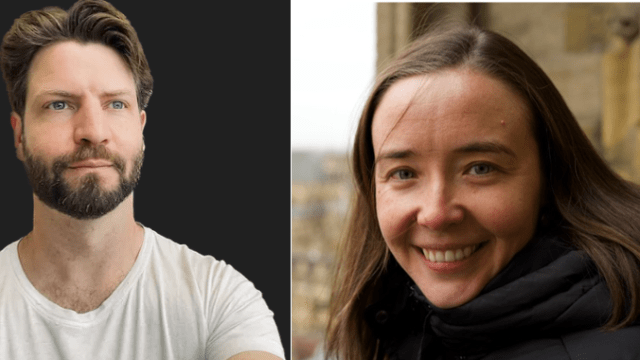
Dr James Nichols, Dr Petra Vaiglova Photo: supplied
Presented in person and online. Zoom details below.
Sequential analyses of tooth enamel stable isotope values have provided valuable insight into patterns of ancient animal mobility and behavior. However, the conventional sampling strategy used in these studies does not closely follow the geometry of tooth growth development. As a result, the biggest challenge to interpreting these hand-drilled enamel sequences is that each sub-sample represents a different and unknown unit of time. This talk will present the results of a mathematical simulation aimed at estimating how much of the original dietary isotopic input can be obtained from faunal teeth using distinct hand-drilling strategies. We use the simulation to test the feasibility of detecting geographically specific seasonal dietary patterns and better constrain the interpretative potential of intra-tooth isotopic sequences in paleodietary and paleoclimatic research. While the results are preliminary, we will discuss future applicability of the simulation for refining inferences of already-published sequential isotope datasets and for informing future research design and planning.
Speaker bios:
Dr Petra Vaiglova is a biomolecular archaeologist focused on exploring the impact of human–animal interactions on ancient landscapes. She is currently developing new ways of extracting geochemical data from animal teeth in order to reconstruct the environments in which the animals lived and understand how the animals’ lives were impacted by past societies. Her research has contributed to knowledge on a range of diverse topics, from the development of farming in Neolithic Greece and Bronze Age China, to the settling of hyper-arid environments during the Byzantine period in the Southern Levant. During her doctorate studies, Petra was a Clarendon Scholar at the University of Oxford and a Pre-doctoral Fellow at the Malcolm H. Wiener Laboratory for Archaeological Science in Athens. She subsequently worked as a Postdoctoral Research Fellow at the University of Haifa, the University of Connecticut, Washington University in St Louis, and Griffith University. Petra currently serves as an Associate Editor for the Journal of Archaeological Science. She is particularly keen about statistical reform and has been active in training students and other researchers in moving from statistical significance to more informative estimation science. In 2024, Petra received an ANU Strategic Learning and Teaching Grant to redevelop the statistical training component of the Master’s of Archaeological and Evolutionary Science program at ANU. Petra enjoys sharing her passion for archaeology and science with the wider public. She gave an invited TEDx talk ‘An archaeologist’s view: how connectivity drove our human past’ and was featured on the Science ANU outreach video ‘What is the SHRIMP Lab?’. She was also spotlighted in a blog post titled ‘Meet Petra: Enthusiasm for Archaeology, Open Science, and Better Statistics’ on the statistical reform website: thenewstatistics.com.
Dr James Nichols is a Lecturer at the Biological Data Science Institute (BDSI) at ANU and an expert in computational mathematics and mathematical data science. His specialty is in high-dimensional approximation and reduced modelling, the computational techniques used to approximate problems with many variables using reduced models (aka digital twins) with vastly fewer variables. His interest in these techniques began while employed at Macquarie Bank, using these techniques to reduce the complexity of exotic multi-asset basket deals. After his PhD, Dr. Nichols was appointed a postdoctoral research position in this field of high-dimensional approximation at Sorbonne University in Paris. One of his articles was awarded the prestigious SIGEST award from the Society of Industrial and Applied Mathematics (SIAM) and was featured in the flagship journal, SIAM Review. He is currently supervising two PhD students and two honours students. He has been teaching the popular ANU 3rd year course Fractals and Chaotic Dynamical Systems (MATH3062), as well special topics courses in optimal transport and numerical approximation at the Mathematical Sciences Institute. James Nichols is convenor of the BDSI Forums, a bi-weekly informal research seminar which encourages the presentation of work-in-progress to foster new collaborations. This series has resulted in several cross-campus interdisciplinary publications with one appearing in Nature Immunology. Dr. Nichols is also one of the hosts of The Random Sample, a podcast communicating the use of mathematics and statistics throughout the sciences. The podcast is produced by the Australian Mathematical Society, the Statistical Society of Australia, as well as several other partner organisations.
Join in-person or via zoom: https://anu.zoom.us/j/84955848358?pwd=BlAgPRsbVdbBo9vrMB8mLEfcgz3FAo.1
Meeting ID: 849 5584 8358
Password: 602080
Presented as part of the School of Archaeology and Anthropology's 2025 Centre for Archaeological Research (CAR) Seminar series
Location
Speakers
- Dr Petra Vaiglova, ANU
- Dr James Nichols, ANU
Event Series
Contact
- Dr Anna Florin